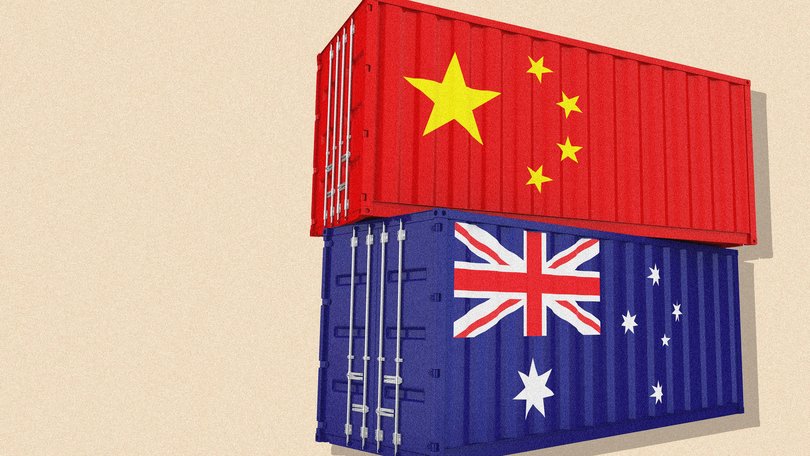JACKSON HEWETT: China trade ties could go beyond basic commodities ... premium products with high margins

Australia’s corporate heavyweights are joining the PM on his Beijing charm offensive and the who’s who list says much about our trade relationship.
The delegate is being spearheaded by Australia’s largest China bull, Andrew Forrest of Fortescue, along with the Australian heads of BHP and Rio Tinto.
Macquarie Bank CEO Shemara Wikramanayake is also with the travelling caravan, as his the head of the Business Council of Australia and representatives of food, education and law.
Sign up to The Nightly's newsletters.
Get the first look at the digital newspaper, curated daily stories and breaking headlines delivered to your inbox.
By continuing you agree to our Terms and Privacy Policy.At a time when Donald Trump is treading on the global rules-based order — with skewering China a key aim — the executives would be keen for a close-up view of how Beijing will respond.
China is by far Australia’s largest trading partner, accounting for $196 billion in exports last year, according to the Department of Foreign Affairs and Trade.
Bulk commodities make up a huge portion of that, starting with iron ore at $105b, LNG at $21b and coal $12.5b.
Foreign students contributed another $13b in 2024, while agricultural products including fish and forest products accounted for $17.2 in 2023.
China is the number one source of imports into Australia, led by telecommunications, computers and cars.
Two-way trade between the countries is $311b, compared to US trade at just $133b. America takes $40b of Australian exports and takes $93b of imports in return.
Professor James Laurenceson, Director of the Australia-China Relations Institute at UTS said Australia “sells more to China than to our next four largest trading partners combined”, and the market will only become more important as Mr Trump turns to tariff screws.
“The US now has a tariff rate ten times higher than what China applies to Australian goods,” he said. “That’s not the world we might want — but it’s the one we’ve got to operate in.”

While the nature of our exports to China are at the commodity end, Mr Laurenceson said “that’s an Australia problem, not a China problem”.
“Commodities dominate all of our export markets, but if you go across the whole suite – minerals, iron ore, fuels like LNG, critical minerals like lithium, crops like wheat, livestock products like beef and wool, fisheries products like lobster, and education and tourism – China is our largest market for all of them.”
Still, some exporters are working to push further up the value chain — transforming Australia’s commodity base into high-margin, premium goods tailored to Chinese tastes.
Jonathon Cox, who runs a premium food and fibre export business into China, says the idea that Australia is just a “rice bowl” undersells the market opportunity.
He said the attraction to Australia’s clean and green image is evolving. Wellness is increasingly becoming a focus of China’s growing middle class, evidenced by the meteoric rise in popularity of brands like Hoka and Lululemon.
“There is an explosion in the health industry,” he said. “That’s something Australia is all about. Consumers aren’t buying on clean and green any more, they are looking for products with functional health benefits. Australia can do that at the premium level.”
Mr Cox, an American who spent ten years in China before moving to Australia has exported more $30 million worth of products into China in the last 3 years.
Among the brands he represents are Remedy Drinks’ kombucha and immunity shots, Minor Figures’ oat milk and Mr Consistent cocktail mixers. He is also imports Tasmanian cherries and lobsters, as well as South Australian wool products.
He said despite the concerns about China’s wealthy scaling back under a crackdown on austentatious wealth by Xi Jinping, there are plenty of cashed up buyers.
“There’s still plenty of people with money — and people who want premium Australian goods,” he said, referencing clients who had no hesitation forking out $400 to $1,000 for wool quilts, or $200 a kilo for Tasmanian lobsters.
“It’s a China numbers game. Even one or two per cent of the population is massive — and that segment is still consuming.”
While lobsters have bounced back, the wine industry is yet to determine whether the collapse in sales following China’s punitive tariffs during a spat with Australia over COVID will ever return.
In 2022, Australian wine exports to China collapsed to just $24m when duties of up to 200 per cent were levied. In 2024, sales were just $13m.
With levies lifted they have bounced back to $1b this year but that is believed to be effectively restocking the shelves. The jury is still out on whether that translates to actual sales.
Mr Laurenceson said levies on wine, lobsters, coal and barley were less about punishment and more about political signalling, including on its own people and warned against interpreting them as proof that China can’t be trusted as a trade partner.
He said the majority of Australia’s top exports — like iron ore, LNG and lithium — were left untouched because China simply couldn’t source those commodities elsewhere at scale. The products that were subject to duties, quickly found a home elsewhere.
“China’s not the only country we’ve got a trust problem with,” he said. “The economic coercion the US is exercising against Australia and the region is orders of magnitude greater.”
Beyond goods and resources, one of Australia’s most powerful exports to China has been education — and its value goes far beyond the $13 billion it added to the economy last year.
In states like Victoria, international education is the number one export outside food and fibre. While enrolments dipped during the pandemic, Chinese students remain a vital market — and not just for universities.
According to the Australia China Business Council, education plays a strategic role in shaping Australia’s long-term position in the region, underpinning tourism, fuelling the visiting friends and relatives economy, and helping establish trust that pays off years down the line in business, investment and diplomacy.
“Some of our best advocates offshore are people who studied here, built lives here, and now run operations that bridge Australia and China,” ACBC President David Olsson said.
Mr Laurenceson said the visit by the Prime Minister would play a critical role in keeping the political relationship calm and functional, even if deeper differences remained unresolved.
“The objective here isn’t to pretend Australia and China are geopolitically aligned — we’re not,” he said. “But both sides know it’s in their shared interest to manage those differences professionally, and allow the rest of the relationship — trade, education, investment — to move forward.”
He said the visit was timely as Trump puts tariffs on its trading partners and noted that most countries in the region, including Japan, Korea, Singapore and Indonesia, continue to support open markets regardless of the US position.
“The US share of global trade is now only 11 per cent,” he said. “So let’s not imagine that the US is the global economy in 2025.”

